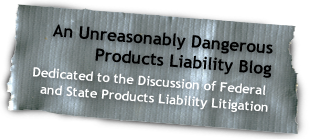In the Fourth Circuit’s recent Barlow v. Colgate Palmolive Company, a dissenting judge determined that the majority rewarded the plaintiffs’ counsel’s bad behavior by refusing to vacate the remand order. The facts underlying this opinion are very interesting. The asbestos plaintiffs alleged their illnesses were caused by exposure to asbestos-containing products manufactured by a number of defendants, including Colgate. Specifically, the plaintiffs contended that their use of Colgate’s “Cashmere Bouquet” power makeup products, which they contended “contained unhealthy levels of asbestos” caused their health problems. However, plaintiffs also named their employers—in-state defendants, which destroyed diversity.
Despite the inclusion of the in-state defendants, Colgate removed the case to federal court arguing that the inclusion of the in-state defendants was fraudulent because the discovery taken in the case, including plaintiffs’ deposition testimony, clearly demonstrated that plaintiffs did not intend to pursue any other defendant. Plaintiffs’ counsel moved to remand the cases and represented that there was some circumstantial evidence that the plaintiffs may have been exposed to asbestos as a result of working for the in-state defendants. Based on those representations, the federal district court remanded the cases to state court.
Eight days after remand, plaintiffs moved to sever their cases from a trial group that was consolidated for trial. In this motion, plaintiffs’ counsel specifically argued that plaintiffs were only arguing that the exposure to the Colgate “Cashmere Bouquet” products was the cause of their illness. Counsel further disclaimed any exposure to asbestos at the plaintiffs’ worksites caused their illnesses. Counsel went a step further and stated: “In short, there is absolutely no evidence to indicate or even suggest that the Plaintiffs were exposed to asbestos in any form other than Cashmere Bouquet.”
Naturally, after receiving this motion, Colgate filed a motion with the federal district court requesting “vacatur of the remand order as a sanction.” The majority decided that it had no authority to provide such relief because the “federal removal statute generally prohibits review of orders remanding removed cases.” The court determined that precedent also did not support Colgate’s requested relief because the court has “said, unequivocally, that ‘the district court has one shot, right or wrong,’ to decide whether a removed case should be remanded.” Further, the court rejected Colgate’s argument that it was not seeking “review” of the federal district’s court’s determination because “it seeks to relitigate the merits of an issue already litigated: whether the plaintiff’s fraudulently joined the nondiverse defendants, which was the issue the first-time around.” The court inexplicably concluded: “Colgate had its chance to prove fraudulent joinder. It failed. It does not get a second try with an improved record.” Finally, the court determined that “if Congress wanted to carve out an attorney-misconduct exception to the prohibition on review of remand orders, it would have done so.”
The dissent, while acknowledging that Federal Rule of Civil Procedure 11 did not provide authority to vacate remand orders, reasoned that the federal district court did have jurisdiction to entertain the Rule 11 motion. The dissent found the majority’s research regarding cases in which court’s embraced Colgate’s argument to be lacking and noted “it appears that every federal court that has addressed” these issues, even the Fourth Circuit. Further, the dissent referenced opinions issued by the Supreme Court of the United States that also determined that federal district courts had jurisdiction to sanction plaintiffs’ counsel.
Furthermore, the dissent determined the majority’s reliance upon the “one-shot” language in Lowe to be misplaced and explained: “[I]f a litigant could flout his duty of candor before a district court and secure remand by misrepresentation, knowing that such remand is never subject to vacatur, he would lose all incentive to present the facts of a case honestly to the court during removal.” The dissent was also critical of the majority’s statement that it would not carve out an exception if Congress had not done so by noting that the case to which the majority cited—Powerex Corp. v. Reliant Energy Servs., Inc. , 551 U.S. 224 (2007)—recognized exceptions that were not carved out by Congress. In sum,
If honesty in the judicial system means anything, it means proceeding with candor before the tribunal, which plaintiffs’ counsel did not do during the removal proceedings. Whatever prolonging of this litigation vacatur of the remand orders might cause [plaintiffs] have only their own lawyers to blame. And the truth is well worth the delay.
Id. at 58.






















